Pest Library
Ants
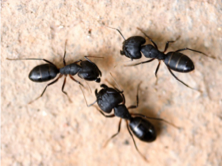
Common Name: Carpenter Ant
Latin Family Name: Formicidae
Origin: Many species of these ants are native to North America, with several species seemingly the most likely to invade structural wood members. There are many destructive species in the Pacific Northwest states, as well as from Florida to the northeast to the southwest and in Hawaii.
Biology: The usual habitat of a colony of carpenter ants is within wood, often wood buried or partially buried in the soil. They also commonly establish “satellite” colonies that may be in a structure, maintaining contact between the two colonies with the workers who travel to and from over well-defined trails. Generally there is a single queen in the colony but often supplementary queens as well. Colonies typically are around 15,000 workers when mature, but potentially could be over 100,000 workers. Foods are both carbohydrates and protein, with insects a major part of the diet. These are single-node ants without a stinger, although they are capable of biting. As they expand their colony they eject “frass”, which is wood chips and other debris such as leftover insect parts. This frass is often seen in structures before the ants are, as they are primarily nocturnal in habit. Carpenter ants are also typically polymorphic, with various sizes of workers in the colony.
Identification: Worker ants are easily identified to the genus Camponotus by the single, large node and the evenly rounded profile of the top of the thorax. It has no dips or spines on it, but is an even, curved line from front to back. There is a circular fringe of hairs around the anal opening and the antennae have 12 segments. Colors range from tan to black to reddish to orange to black/red combinations. Workers vary from 6 to 13 mm in length.
Characteristics: Finding and treating directly into the nest with a residual insecticide will result in effective kill of the ants there, and a dust insecticide may be most effective. Satellite colonies in structures may be treated directly, or with applications into voids the ants travel through. Bait products seem to be accepted readily as well. Reduction of excessive moisture in the structure and removal of unnecessary wood materials outdoors will reduce the attraction of an area.
Common Name: Argentine ant
Latin Family Name: Iridomyrmex humilis
Origin: Thought to have arrived from Brazil in ships transporting coffee around 1891, and now found throughout North America, in Hawaii, and on most other continents throughout the world.
Biology: Though the Argentine Ant is a small, non-stinging ant, it is a very territorial and aggressive ant that will drive away or kill competing ant species. Neighboring colonies of Argentine ants appear not to be aggressive toward each other, allowing for the rapid spread and domination by this species. Colonies contain thousands of workers and many queens, and mating will take place within the confines of the colony. New colonies are often formed by budding off from the parent colony. Nesting is usually in the soil, commonly under concrete slabs, but may also be found in any other convenient void, such as in trees, wall voids, under insulation, or under debris on the soil. Soil nests are generally very shallow. While protein foods are part of their diet, their preferred foods are sugars, including household food products, fruits in gardens, and honeydew.
Identification: This is a single-node species with small workers only about 2.5 mm long, and with all workers the same size. The Argentine can be separated from the similar Odorous House ant by its visible node and by its dull gray-black to gray-brown color. When viewed from the side the Argentine Ant has a distinct dip in the top of the thorax. There is no circle of hairs around the anal opening. The first segment of the antenna is not longer than the head, and the legs are not noticeably long, as compared with the crazy ant.
Characteristics: Control of most ants includes correction of the attractions that drew them to a property, including harborage sites, food sources, and moisture conditions. Elimination of insects that provide protein or honeydew sources reduces ant foraging in an area, very important for this species, and cleanup of unnecessary debris or objects on the soil that provide harborage eliminates nesting. Ant bait products in granular, liquid, or gel formulations can be effective, and carbohydrate baits may be preferred. Locating the nest of these ants is critical, and if it is found treatment directly into the nest with a residual dust insecticide can be effective
Common Name: Red Imported Fire Ant (RIFA)
Latin Family Name: Formicidae
Origin: RIFA originated in South America, entered the United States in the southern states around 1930, and spread rapidly to 17 southeastern states. It has since spread to California and isolated incidents have occurred in other states.
Biology: This double-node ant is one of the worst ant pests in the U.S., in terms of human health, property damage, and environmental damage. Colonies may have several hundred thousand workers and dozens of queens in them, and workers very aggressively defend their nest with stinging. Their nests may be located in equipment, causing damage to it, as well as within structures. Nests most commonly are in the soil, identified by the large mound of soil raised above the surface, and they are particularly common in turf. The workers are aggressive predators, feeding on any other insects they find as well as small mammals or birds, earthworms, frogs and lizards. They dramatically alter the natural habitat when they move into an area. RIFA nests may go as deep as 8 feet in the soil, and have mounds above ground as tall as 3 feet and 2 feet in diameter. They are nocturnal except when the mound is disturbed, at which point they rapidly overwhelm the intruder, and on a chemical command commence stinging simultaneously. Nests may be found in wall voids, rain gutters, bath traps, and under carpets, as well as in electrical equipment. There may be numerous queens in a colony with numerous satellite colonies attached. Their spread may be by budding, and up to 200 mounds per acre have been found.
Identification: RIFA is identified by its red head and thorax and red/black abdomen. Long bristly hairs are found over the thorax and abdomen and no spines are on the thorax. The antenna is composed of 10 segments with a 2-segmented club at the end. RIFA may be separated from other fire ant species by the presence of a dark patch in the middle of the “forehead” area and a short, downward-projecting spine on the clypeus between the jaws. This is a highly polymorphic species, with various sizes of workers within a single colony.
Characteristics: Due to the large colony size, deep nests, and sensitivity to chemicals, baiting is a preferred method of control, and baits with an oil attractant appear most acceptable. Mound injection with dust or liquid insecticide can be effective, but may not penetrate throughout the colony. Physical disturbance and flooding of the mounds do not work. Elimination of unnecessary moisture sources will reduce the attraction of an area for these ants.
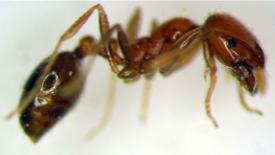
Common Name: Southern Fire Ant (California Fire Ant)
Latin Family Name: Solenopsis xyloni
Origin: Native to the southwestern United States, and found in California and Arizona.
Biology: This fire ant is not nearly the pest and health problem of the Red Imported Fire Ant, but as a double node ant it still can sting aggressively. Nesting and activity are generally confined to the outdoors, but foraging or nesting within a structure does occur on occasion. Nests are commonly located under objects or debris on the soil as well as under slabs. Foods consist of a wide variety of protein and carbohydrate materials, including honeydew, fruit and vegetables, other insects, greases, and grains.
Identification: This species is identified by its red head and thorax and red/black abdomen. Long bristly hairs are found over the thorax and abdomen and no spines are on the thorax. The antenna is composed of 10 segments with a 2-segmented club at the end. The Southern Fire Ant may be separated from other fire ant species by the lack of a dark patch on the “forehead” area and no downward-projecting spine on the clypeus between the jaws. In addition, on the front of the two nodes on the waist there is a short spine at the front of the lower surface, and this does not occur on the Red Imported Fire Ant. This is a highly polymorphic species, with various sizes of workers within a single colony.
Characteristics: Baiting is a preferred method of control, and baits with an oil attractant appear most acceptable. Mound injection with dust or liquid insecticide can be effective, but may not penetrate throughout the colony. Physical disturbance and flooding of the mounds do not work. Elimination of unnecessary moisture sources will reduce the attraction of an area for these ants, as well as elimination of food sources and other insects.
Bees
Common Name: Carpenter Bee
Latin Family Name: Xylocopa
Origin: A number of native species of these bees occur in North America.
Biology: Carpenter bees are solitary bees that get their common name from their habit of boring chambers in solid wood in order to create living quarters for their larvae. Softer woods such as redwood may be preferred, and the wood is not eaten, but instead is reduced to sawdust (“frass”) which is ejected from the tunnels. The female bee does the excavating, and several females may be working in the same section of wood and using the same entrance hole, but creating separate galleries. Males and females over-winter in old galleries and emerge in the spring to mate. They will both die before the end of the summer and it is their offspring which begin the next year’s activity. The galleries may be used repeatedly, with each new female lengthening the tunnel, which often can be over 10 feet in length. She creates an average of 6 or 7 cells, each separated by a plug, and places an egg and a food supply of pollen and nectar in each cell. Once this is completed she never returns to care for the larvae.
Identification: There are several species of carpenter bees that are fairly small, but the common Xylocopa species that may invade structural wood are some of the largest bees in North America, with some of the largest over an inch long. Coloring normally is shiny metallic blue-green to black, although the male of the Valley Carpenter Bee is light tan. They may be separated from bumblebees by the relative lack of hairs on the abdomen, as well as by their more rapid, erratic flight habits Damage from these bees is hidden within the wood, often with only the round entrance hole visible. Within the wood the galleries extend with the grain of the wood, and are almost perfectly round, ending with the cells in which the larvae develop.
Characteristics: Surface coatings of paint or varnish are somewhat repellent, but not always. Injection of a residual dust insecticide into the gallery opening, followed by placement of a plug in the opening, will confine the bees to this treated area if done at night. Holes can then be permanently sealed.
Roaches
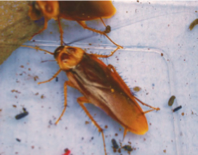
Common Name: American Cockroach
Latin Family Name: Periplaneta americana
Origin: Possibly from northern Africa or Asia, but found worldwide for many centuries now. It occurs throughout the United States as a common indoor and outdoor cockroach, and in some areas may be more common than the German roach.
Biology: This species is common outdoors in landscape plantings, in sewers or storm drain systems, and in lower areas of buildings where moisture may be greater. It may inhabit storm drains in huge numbers, emerging though man-hole covers at night to invade buildings. They will feed on most carbohydrate or protein based materials, including human hair or finger and toenails. Each female produces around 10 egg capsules, carrying the capsule for a day or two and then carefully placing it in a protected location. Each egg capsule has an average of 15 eggs in it and these hatch in about 45 days. Development to the adult stage averages about 450 days, but may take well over 2 years in colder climates. Adults live an average of around 1 year, but potentially can live almost 3 years.
Identification: The American roach adult has fully developed wings and is capable of some flight, usually from an upper location to a lower surface. It is reddish brown with a yellow ring around the prothorax. Adults may be up to 1.5 inches long from head to tail, with extremely long antennae. The cerci are long and thin, a character that separates the nymphs of American roaches from those of Oriental roaches.
Characteristics: Since this species is abundant outdoors, control begins with habit management in the outdoor areas. Removal of harborage sites under debris or piles of wood and discarded materials will reduce populations near a structure. Control of food and moisture sources outdoors and indoors are important. Granular insect baits are well accepted, and the use of a perimeter treatment with a residual insecticide will intercept many individuals that attempt to access a structure.
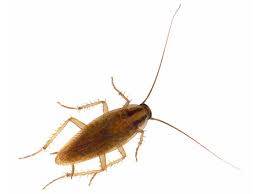
Common Name: German Cockroach (Steam Fly, Water Bug)
Latin Family Name: Blattella germanica
Origin: Apparently the German roach originated in Africa, but was transported through early commerce to Europe and now is found throughout the world.
Biology: The German roach is a nocturnal animal, strongly avoids light, cannot fly, and in almost all situations will be found indoors. Infestations normally begin by the introduction of roaches in packages. The biological potential of this species is enormous, with females producing an average of 5 egg capsules in their lifetime, each with an average of 30 eggs in it. The time from egg to mature adult averages about 3 months, allowing 4 generations of the insects each year. Female adult roaches live for about 200 days. Females carry the egg capsule until one day before the eggs are to hatch, providing necessary moisture into the eggs. Her activity level is low while she is in this “gravid” stage. This species has a higher moisture requirement than many other species, and is most likely to be living near moisture sources and in humid areas. First instar nymphs often remain in hiding, feeding on the fecal material of other roaches. Older roaches are extremely variable in their diets, feeding on virtually any materials in a food environment. They may also nibble on human hair or finger and toenails.
Identification: The German roach is typical of the genus Blattella, with a tan to brownish color, small size, and two dark, longitudinal stripes on its prothorax. Adults reach about ½ inch in length, with wings that reach the end of the abdomen in females and just beyond the tip of the abdomen in males. Neither is capable of flight. Nymphs begin as extremely small insects and without any hint of wings. However, they do have the dark markings on the prothorax. This species may be distinguished from the Field roach by the color of the face, which is light brown in the German.
Characteristics: Successful control relies heavily on habitat modification to eliminate food and water resources and to close access to harborage sites. It also is dependent on an inspection to discover all harborages that need to be treated or eliminated. Crack and crevice applications of a residual insecticide are effective, along with treatment of voids with a void injector or dust application. Bait products introduced in the 1990’s have been highly successful against the German Roach.
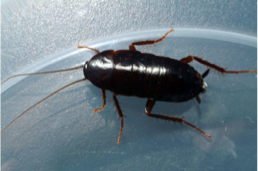
Common Name: Oriental Cockroach (Water Beetle, Shad Roach, Black Beetle)
Latin Family Name: Blatta orientalis
Origin: Believed to have originated in Africa, but now found throughout the world.
Biology: Oriental roaches inhabit damp locations such as crawl spaces under structures or underground water and sewage systems. Their travel through such unsanitary habitats increases their potential as disease vectors. It may be common in outdoor environments and enter a structure on its own, by crawling under doors or through other exterior openings. Females carry their egg capsules for about one day, and then deposits the capsule in a secluded place. Each capsule has an average of 15 eggs, and the development from egg to mature adult takes about one year, although in some circumstances it has been observed to take about 2.5 years. The insects are nocturnal, avoid light, and neither sex can fly, although the male has well developed wings.
Identification: These are large roaches, with adults reaching about 1 inch in length. They are very dark brown to black, with the females having an oval shape. The wings of the males do not reach the end of the abdomen, and the wings on the females are reduced to short stubs at the back of the thorax. The nymphs of this species are very similar to nymphs of the American roach, but may be distinguished by their cerci. On the Oriental roach the cerci are short and somewhat widened, while on the American they are long and thin.
Characteristics: Since this species often enters structures by walking in or entering through drains of various kinds, entry points must be dealt with the exclude the insects. Removal of vegetation and harborage sites around the exterior of the building will reduce the presence near the structure. Granular insect baits appear to be very attractive to the Oriental roach, and applications of residual insecticides around building perimeters, in drain openings, or in sewer and storm system openings will help to control them.
Other Pests
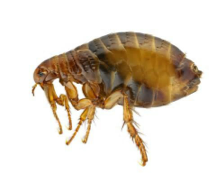
Common Name: Flea
Latin Family Name: Ctenocephalides felis
Origin: There are dozens of different species of fleas, but the Cat Flea is by far the most common flea on pets and in structures in the United States. It originated in Africa as an ectoparasite of the large native cats.
Biology: The Cat Flea is a blood feeder as the adult, and a scavenger as the larva. The adults remain on the animals they feed on unless physically forced off, and may live up to a year. The female lays the eggs on the host animal and these eggs fall off to the floor or other surface below. The eggs hatch in a few days and the larvae begins to feed on organic debris it finds, but also must consume some dried blood in order to progress to the pupa stage. This blood is from the dried feces of the adult fleas, and it falls off the pets wherever they spend time. Under ideal conditions the time from egg to adult can be as short as 2 weeks, or it may take several months if there is no host activity to stimulate some of the pupa to hatch to the adult stage. The Cat Flea is a possible vector of bubonic plague, and it is a common flea species on raccoons and opossum, as well as the primary flea on both dogs and cats in the U.S.
Identification: All fleas are similar in appearance, as wingless insects with bodies flattened from side to side and with long hind legs for jumping. They are black to reddish black in color and have spiny legs as well as rows of spines along other body areas called “combs”. These combs are important for identification of the species. The genal comb is a row below the head, and the pronotal comb is a row behind the head, at the back of the pronotum. The Cat Flea has both combs, it has eyes present, the genal comb is horizontally placed, and the first two spines on the genal comb are the same length. These characters separate it from the similar Dog Flea. Flea larvae are rarely seen, but they are legless and whitish with a brown head, unless they have fed on fecal matter from the adults, in which case they assume a reddish color. They are covered with short hairs, and when disturbed are able to flip about violently in order to escape.
Characteristics: Elimination of fleas on household pets will be important in preventing the production of eggs that fall onto carpeted areas inside. If an infestation is occurring due to breeding and larvae on the interior it generally is controlled with an application of a residual insecticide, preferably with the addition of an insect growth regulator as well. Vacuuming of the carpet prior to the application as well as following it will be important, as this vibration and contact will stimulate the emergence of adult fleas from the pupa, exposing them to the pesticide application.
Common Name: Yellowjacket (Paper Wasps, Meat Bees, Hornets)
Latin Family Name: Vespula
Origin: There are many species of Vespula in North America, including several species introduced from Europe. Two of these, Vespula germanica and Vespula vulgaris, are among the serious scavenger pests in this group.
Biology: Yellowjackets are social wasps, with a Queen that initiated the colony and female workers that build the nest, care for the young, forage for food, and defend the colony. Colonies typically begin each spring and die off each fall in cooler climates, but may survive over the winter in warmer climates. The population of the colony easily grows to many thousands of workers by the end of the summer, at which time males are produced, mating with new queens takes place, and these fertilized queens then over-winter in protected locations. Adults feed on sweet liquids such as honeydew, nectar, fruit juices, or human foods such as sodas. They also relish a sugary material exuded by the larvae. The larvae are fed meat, and natural sources are insect larvae or bits of flesh from dead animals. As scavengers the workers also gather human foods at outdoor eating areas. The workers are all able to sting repeatedly, and very aggressively defend their colony from perceived intruders. Nests are placed either in aerial locations, including trees, shrubs, wall voids, or attics, as well as in the ground, where workers enlarge holes they find to accommodate the growing colony. The nest is created from cellulose gathered from tree bark, dried plant materials, or other sources, mixed with saliva, and formed as the hexagonal cells for the larvae.
Identification: Yellowjackets are very similar to the other social paper wasps called Umbrella Wasps, but differ by having no narrow waist between their thorax and abdomen. Colors are yellow and black, and specific identification of each species is done with differences in the patterns of the black patches around the eyes and head as well as on the abdomen. Yellowjackets, as wasps, have 2 pairs of wings that are dissimilar in size and shape. This separates them from many species of flies that mimic wasps, where there is only 1 pair of wings.
Characteristics: Elimination of attractions such as spilled food materials or rotting fruits in gardens will help to prevent the presence of yellowjackets. If they are nesting within a structure the nest itself or openings the workers use for entry may be dusted with a residual insecticide. Baiting using meat or syrups as the attraction will work very well if a product labeled for use in this manner becomes available. Trapping will capture many of the foraging workers around human activity areas, but is unlikely to cause a large reduction of the nest population.
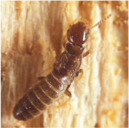
Common Name: Termite (Reticulitermes, Subterranean Termites)
Latin Family Name: Reticulitermes
Origin: Six species of native termites in this genus occur in North America, occurring throughout the country in all states and in Canada. These are the common and destructive soil-dwelling termites.
Biology: With very rare exception colonies are located in the ground, with foraging done from these colonies into structures or other wood sources. There is a true worker caste, with adult workers, soldiers, and alates in the colony. It is possible that a colony can have up to two hundred thousand workers or more, and several separate colonies may exist near and be foraging in a single structure. Swarming by the alates may consist of many hundreds of alates from the colony, and many colonies in an area releasing swarmers simultaneously. This usually occurs in late morning to mid-day on a sunny day following a rainfall. Most swarming is in the spring, but fall swarms are also common, and a colony will be at least 3 years old before it produces swarmers. The wings are shed shortly after the flight takes place.
Identification: Alates are a shiny dark brown to black, and have both a fontanelle as well as a single ocellus near each compound eye. The antennae have less than 18 segments. The wings are very light colored to white and are without hairs on them. There are 2 thickened veins that run parallel to each other from the base to the tip along the leading edge of the wing, and numerous short veins connect these two long veins. Soldiers have head capsules that are as long as the rest of the body, and the sides of the head are parallel. The jaws are symmetrical and without teeth along their inner margin, and they remain parallel to each other without having the tips crossing.
Characteristics: Control is primarily by soil applications of residual insecticides, either as pretreatments or as treatment post-construction. Termite bait products may prove to be effective in eliminating underground colonies altogether. Control of excessive moisture conditions and unnecessary wood materials under or near the structure are preventive measures
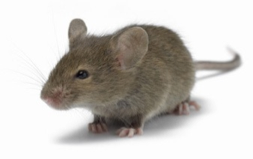
Common Name: House Mouse (Field Mouse)
Latin Family Name: Mus musculus
Origin: This species originated in Eastern Asia in arid grasslands, allowing it to evolve the ability to survive without needing frequent water. It now occurs throughout the world.
Biology: A prolific breeder, the House Mouse is sexually mature at 2 months old, has a gestation period of only 3 weeks, and averages 5 to 8 young per litter, but potentially up to 15. Each female may give birth to 8 litters. The life span can be from 2 to 3 years. The House Mouse is a nibbler, consuming small quantities of food at many feedings. They are “curious”, and tend to investigate new objects that are placed in their environment. Favored foods may be grains, dried fruits, nuts, and sweet materials. They are known reservoirs of diseases such as rickettsial pox (mites), typhus (fleas), and filth problems with Salmonella, tapeworm, roundworm, and others parasites.
Identification: Adults remain small, less than 7 inches long from tip of nose to tip of tail. They have hairless, scaly tails that separate them from meadow or deer mice, and ears relatively bare of hairs. A young rat looks similar to the House Mouse, but the rat has feet and eyes that are disproportionately large in comparison with its head and body.
Characteristics: The full complement of traps and baits are effective on mice. Exclusion should consider closing any openings as wide as a quarter of an inch, along with elimination of any harborage sites that are not needed, such as waste piles, packing boxes, wood piles, or heavy outside vegetation. Like the other domestic rodents they prefer to remain against vertical surfaces, in contact with their “guard hairs” on their body, and control measures should be placed against these pathways.
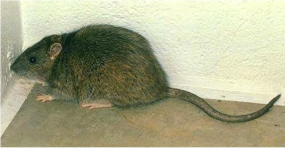
Common Name: Norway Rat (Brown Rat, Ship Rat, Wharf Rat, Sewer Rat)
Latin Family Name: Rattus norvegicus
Origin: Evolved in Central Asia, but reached Europe in the 1700’s, the United States later that century, and now it is found throughout the world. It is a rodent of cooler climates, but now also infests many tropical environments as well, primarily in the seaport areas.
Biology: This rat is commonly sold as a \“pet rat\”, and has been bred for white coloration as “lab rats” as well, leading to the occurrence of white and brown marked races. It is primarily a ground dweller, although it can climb very well, and prefers to reside in burrows. It swims very well and often lives in sewers and other underground water systems. It is primarily a nocturnal animal, and will restrict its range of movement only to that which is needed to find food and water, perhaps only 20 or 30 from home. Norway Rats are omnivores and opportunistic feeders, feeding on any natural or human foods available. They are neophobic and may avoid new objects placed in their environment for some time. A normal life expectancy for them is one year or less, although when cared for they may live several years. The gestation period of the female is 22 days, litters average 8 to 9 pups, and she may have several litters in her one year. Damage from gnawing can be extensive, as they chew on pipes of plastic or metal, wires, wood, or furnishings and walls, and commonly bite humans. While not the primary reservoir of bubonic plague, they have the potential to spread this disease, along with several others as well as filth infections.
Identification: Adult rats are large and robust, being up to 16 inches from nose to tip of tail. Their tail length is shorter than their body length, and it is scaly and almost without hairs. Colors range from white to brown to mottled, or blackish gray, reddish brown, and other variations. In relation to its head it has a blunt nose, small eyes, and small ears.
Characteristics: Habitat modification to eliminate harborage sites is effective, along with proper building maintenance to exclude their entry. Elimination of available interior and exterior food and water supplies is needed. Burrows may be treated by fumigation in some circumstances, and the use of traps and baiting are highly effective. The shyness these rats exhibit toward new objects can affect the response to bait boxes and traps. Glue trays may not be highly effective due to the strength of this species, and its ability to pull free from the glue. Like the other domestic rodents they prefer to remain against vertical surfaces, in contact with their “guard hairs” on their body, and control measures should be placed against these pathways.
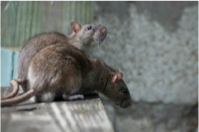
Common Name: Roof Rat
Latin Family Name: Rattus rattus
Origin: Native to forested areas in Southeast Asia, but transported into Europe by caravans as early as the 11th century. It was the common structural rat in Europe during the Black Death episode in the 14th Century. It arrived in the United States somewhere in the 1500’s, although this is not certain. In the U.S. it is not as widespread as the Norway Rat, generally staying within 100 miles of a coastline, and occurring throughout cities from Washington to southern California, along the Gulf Coast and up the entire eastern seaboard.
Biology: The Roof Rat is an “arboreal” animal, preferring to live above ground level in trees, although it has adapted well to upper areas of structures as well, living in attics and traveling by means of wires and cables attached to homes. It is nocturnal and secretive, staying out of view within the foliage provided in landscaped environments, and feeding heavily on the fruits, nuts, vegetables, or garden snails found there. Like the Norway Rat is also is shy about new objects in its familiar environment, and may avoid control measures such as traps or bait stations. A normal life expectancy for them is one year or less, ranging from 5 to 18 months. The gestation period of the female is 22 days, litters average 8 to 9 pups, and she may have 3 to 4 litters in her one year, being somewhat less prolific than the Norway Rat. Peaks in breeding occur in the spring and the fall. Problems from Roof Rats include the potential for disease, such as plague, spread by their fleas. They are extremely destructive to stored food products in structures, crops in residential areas, and cause tremendous damage due to their gnawing on structural members, pipes, and electrical wires.
Identification: The Roof Rat is a smaller, slimmer rat than the Norway Rat, and cannot compete with the Norway when space is limited. Its tail is noticeably longer than its body length, the best ID characteristic in the field. In relation to its head it has a pointed nose, large eyes, and large ears. Its color is dark gray to black with a lighter grayish belly, and it ranges to a lighter brown depending on which “subspecies” is present.
Characteristics: Exclusion from structures is of high importance in preventing entry and damage from this rat. They can enter through any opening wider than one half inch, swim well, and can climb any rough surface, along wires and cables, and can jump vertically about 3 feet. Glue trays work very well for Roof Rats, along with snap traps placed in runways and bait stations using various formulations. Like the other domestic rodents they prefer to remain against vertical surfaces, in contact with their “guard hairs” on their body, and control measures should be placed against these pathways.